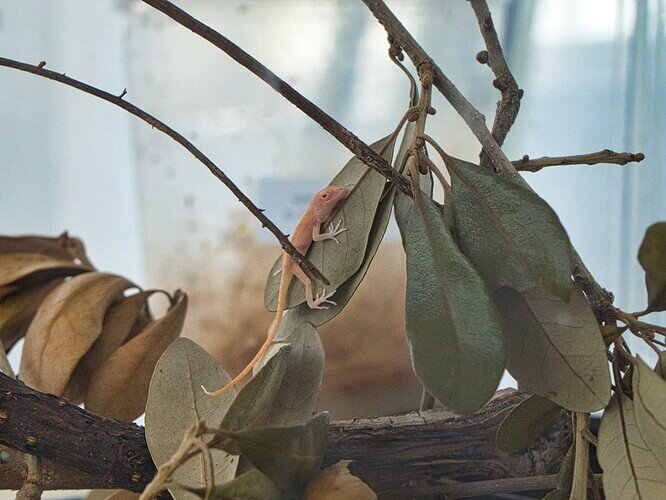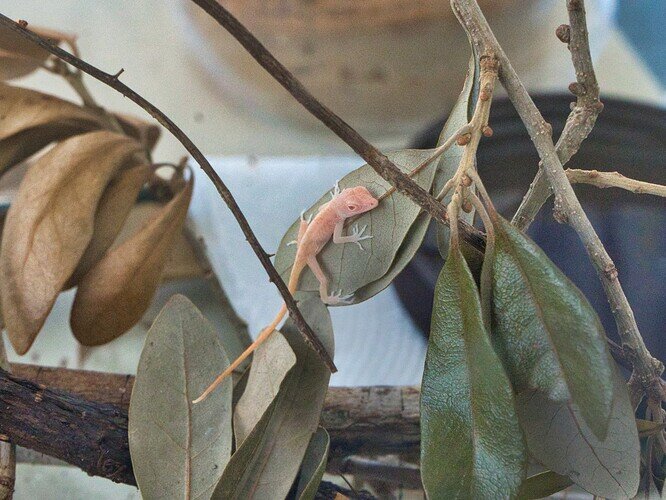I have lived in central Florida my entire life, and I have never seen an albino anole until my wife caught this one in our yard recently. I saw something about the University of Georgia gene editing one to make an albino. Do these occur in the wild very often? From what I can tell it’s pretty rare to find one.
That’s very unique! Do you know if it’s legal to keep a wild anole? Because, if it is I think it would be great to breed it to other anoles and produce more albinos. I just did a quick google search and aside from the genetically edited ones I don’t think any have been found and kept. Since I doubt lab animals will be sold into the reptile keeping hobby, this could be a chance to create albino anoles in the hobby.
As far as I know, it’s not illegal. I am not sure where to look for that information though. We have it in a tank currently and feeding it mealworms and fruit flies. It would be very cool if we could breed it! I am not sure how to tell what gender it is (usually I can recognize it from the color  ). Ideally, I think it would be cool to keep it, but if it becomes too difficult, we could sell it or donate it to our local zoo which is well respected.
). Ideally, I think it would be cool to keep it, but if it becomes too difficult, we could sell it or donate it to our local zoo which is well respected.
Do you know what species of anole it is? If you post a picture of the vent area (underneath the base of the tail), someone on the forums might be able to sex it. If you want to prove it out I would buy a captive or catch a wild anole that’s of the opposite sex, and they could possibly be kept in the same enclosure (I don’t know much about anole care, you would need to research it). It is illegal in most states (I don’t know about Florida specifically) to capture wild animals for commercial purposes. That would likely make it illegal to sell it, but you could still donate it. I know that a lot of zoos won’t accept animals from the public to avoid transmission of diseases. But, I’m sure a local reptile breeder would be happy to take it off your hands if you needed to get rid of it.
It entirely depends on the species of anole. Only green anoles are native to Florida, all others were introduced and are technically considered invasive species. If it is a Brown or Knight anole, it can be kept without issue, though I’m not sure on any others.
I am not sure what species it is yet. I will try to upload more photos if I can get them later. I had not even thought of the legal side of things, so thanks for bringing that up. I will try to do more research on that and see what I can find
After looking up some pictures I think it’s a brown anole, but I’m not sure, it looks pretty young too, so it might be hard to ID.
If in fact it is a brown anole that would be pretty interesting. According to this article University of Georgia genetically modified brown anoles to express the Albino phenotype.
As for the “rarity” of this anole, the answer is that they’re likely a lot more common than we know, but they don’t make it to adulthood. Anoles rely on their colouration to blend in with their surroundings, so any albino young in the wild would be picked off quite easily. Which makes sense as to why you found a youngster.
Wow what a cutie!
It’s hard to say on one so small but for me it looks like a green anole juvie. The albino really does mess with ID. The tail looks longer and the nose looks a bit more tapered and slender so it may grow out more with age.
I wonder if you could check it under a blacklight and see more patterns? Greens will typically be pretty soild with some individuals showing a white stripe down the spine. Browns will have more pattern.
As the little one gets older, males will gain that telltale bulge just past the cloaca and develop the dewlap under the chin. Females will sometimes do the dominance displays of head bobbing with each other but no dewlap display.
If you do decide to keep it and were thinking about breeding ,try to find one close to the original location , that way you might strike lucky and find a het.
I’ve seen albino Anoles before but they definitely aren’t common, i just watched a video on YouTube of a guy that produced an albino Anole, he said he didn’t intentionally breed one it just came about.
Anoles are fun little lizards, i use to have so many of them as pets, pretty easy to care for, with an albino id definitely keep it a bit dimmer with regards to lighting since they are sensitive. Give them some broad leaf cover on their branches to hide under if they need.
That is so SO COOL!! I love anoles, they’ve got such great personalities. There are lots of them where I live in Coastal Mississippi but I surely haven’t seen one like your find. Does it have any pigmentation at all? Any ability to change colors? I do hope you keep us updated on this little one.
Just to note that albinism is usually recessive in most animals (I’ve not checked the paper Don posted yet to see if it’s the same in anoles, but if it is…)… What are the chances of the only 2 het albinos meeting around your yard? I’d bet you have a local group of het/pos hets
Albinism can also just be a random mutation. There don’t have to be hets involved.
I could be wrong, but if the mutation happens on the sex chromosomes (of the parents) rather than the offspring that it occurs on, both parents would have to have that mutation to create a visual offspring. My guess is that an anole had a mutation for albino (het form) and the heterozygous form started spreading across the population, and two het individuals had an offspring, the offspring survived long enough and it was found by the OP.
I have bred brown and green anoles in the same cage. Interesting enough as close as they are related they do not cross breed. The greens only breed with the greens. In my observations in captivity the browns seems to be much more aggressive with everything from food to breeding and territory. If you cant figure out which it is I would put both green and brown anoles in and see which it breeds with. As far as the male bobbing and FULL displays of the colorful dewlap they only react to their own. So you can tell from that behaviour as well.
Now the question is will the non-albino/normal anoles recognize it.
Sorry I haven’t had a chance to reply here. The albino (which we have named Casper), is doing well and eating most times when we hand feed it. Sometimes it does not seem very hungry, so it may be eating on its own some of the time. Pretty sure it’s a male.
Albino brown anoles have vision problems and in our experience require hand feeding. Therefore, it seems unlikely that they would be popular in hobbyist community.
All albino animals will be sensitive to light. But, if this current animal was able to survive in the wild for a time and is currently eating well, it might just depend on the individual animal or the conditions.

